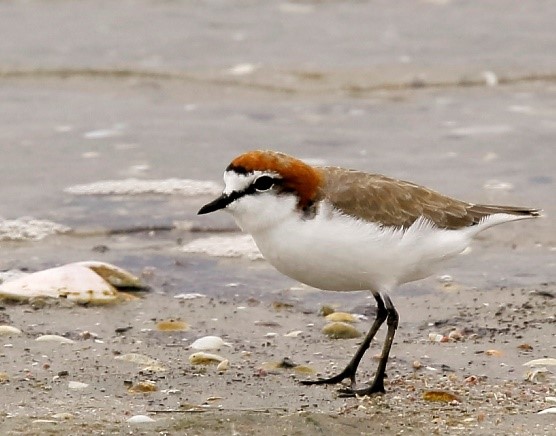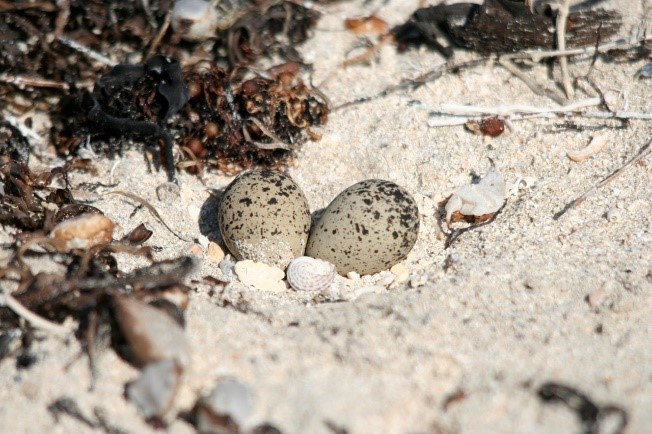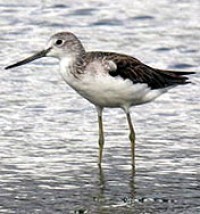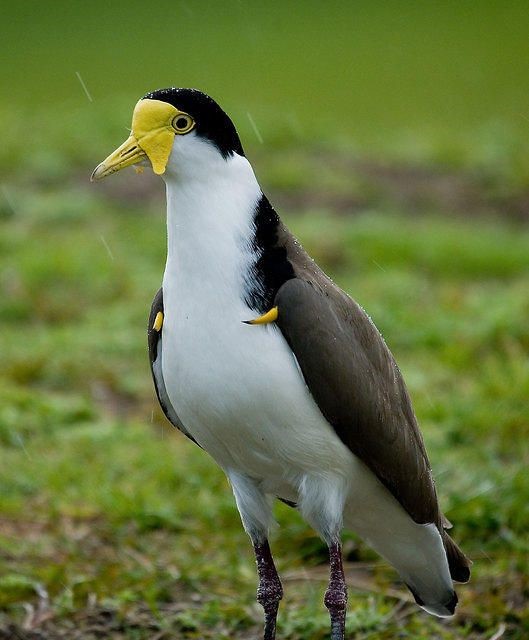This month is an ideal time to observe some of the numerous shoreline birds that run along, breeding and feeding, on the edges of our Lake, Ponds, Creek and Wetland. The most common birds seen around Sanctuary Lakes are the Red Capped Plover, the Common Greenshank and the Masked Lapwing. In fact, when I started research on this article last week, I saw all three of them together at the Sanctuary Lake’s Salt Ponds by the Skeleton Creek weir. Let’s start with the smallest and probably the most common, the Red Capped Plover or Dotterel.
The red-capped plover or dotterel, or small plover (Charadrius ruficapillus)
The Red-caps are usually seen running along the water’s edge using a distinctive 'stop-run-peck' foraging method. They feed on small crustaceans, molluscs, other invertebrates and some vegetation. Although the Red-cap inhabits many of Sanctuary Lakes varied shorelines, it can, due to its size and camouflageable markings, be difficult to view. It’s beak to tail size is only the same as the small house sparrow, 16cm.
Red-cap males have a bright reddish-chestnut nape (back of neck) and crown, with a black stripe running from the bill to the eye and one running from the nape to the breast and the females have a grey-brown crown, a pale red-brown nape and less distinct black markings.
Red-Capped Plover’s nest
Red-caps are beach and shoreline-nesting birds. Laying their eggs in a shallow scratched out depression close to the water. The small eggs are extremely well camouflaged and can be accidently crushed by shore users including humans, animals and vehicles. The birds are very susceptible to disturbance during the September to October breeding season, often meaning that the eggs fail to hatch or chicks don't survive. To help protect the nests and young, Red-caps will often attempt to distract the intruder, including faking a wing injury to lead predators away. 
Common Greenshank Tringa nebularia
Unlike the Red-cap the Common Greenshank are readily distinguished when strutting around the margins of our shore and waterlines. Firstly, they are relatively large, 35cm and have a prominent white triangle on their back. Secondly, by their strident ‘choo, choo, choo’ call given when flying away, in their very distinctive zig-zag pattern. They are migratory, flying between Australia and Siberia. Arriving here in early October and leaving around February/March. The Common Greenshanks do not breed in Australia but on their return back to Siberia.
The Common Greenshank is a rather heavily built wader. Mainly grey-brown on its upper body and pale below. The head and neck are flecked with dark grey and there is a narrow white eye ring. The bill is dark to green-grey and is long with a slight upward curve. The long legs are yellowish-green. In flight, the Greenshank has a dark outer-wing and the signature white triangle can be seen on the rump and back.
Greenshanks eat insects, worms, molluscs, small fish and crustaceans, feeding both by day and night. They feed by picking from the surface, probing, sweeping and lunging at the edges of mudflats or shallows. Walking elegantly along the shoreline it often catches small fish by chasing them rapidly in the water. It may also run erratically through shallows to catch shrimps with its long upcurved bill held slightly open.
Masked Lapwing Vanellus miles novaehollandiae
Masked Lapwings are a common sight in our neighbourhood. Presently we have two pairs residing with us. One pair are regulars around Breezewater and the 8th tee’s pond, with the other pair nesting on the Lake’s shoreline between the 17th green and the 18th’s fairway.
Masked Lapwing is native to Australia. Both sexes are similar, in size (length 36 to 38cm, wingspan 80 cm) and appearance. The adults have olive-brown upperparts and wings. Flight feathers are blackish. Rump is white. Tail is tipped black. Underparts are white. Undertail feathers are white, tipped with black and the crown is black. Both sexes have the distinctive nomenclature, yellow wattle masks on the face, and yellow bare skin covering forehead and upper area of eyes. The nape is separated from the mantle by a white collar. The bill is yellow with pale greyish tip. Eyes are yellow with yellow eye-ring. Legs and feet are dark pinkish.
The Masked Lapwing is sometimes referred to as the Spur-winged Plover because each of its wings are armed with a yellow spur at the ‘elbow’ or carpal joint. Indigenous people used to say that the birds were carrying yellow spears. Lapwings use these spurs when diving at potential predators or intruders during breeding season, while chicks are running around or when the eggs are just about to hatch. As some SL Golfers will testify these attacks are quite unnerving, although the birds never actually strike their ‘victims’, preferring a close approach with plenty of screeching to scare them away. Like the Red Capped Plover, Lapwings also perform the “broken wing manoeuvre”, in order to lure predators away from the nest. Usually, these behaviours cease after hatching and when chicks are mobile. Parents defend large territory around chicks, rather than the nest-site.
The Masked Lapwing searches for its food mainly on the shoreline, marshes and nearby grassy areas. They forage by raking steadily with one-foot extracting invertebrates, insects, larvae and earthworms from just below or on the surface. These birds often feed alone, or in pairs.
Strangely Masked Lapwings may breed at any time of the year when conditions are suitable. Both sexes share the building of the nest, which is a simple scrape in the